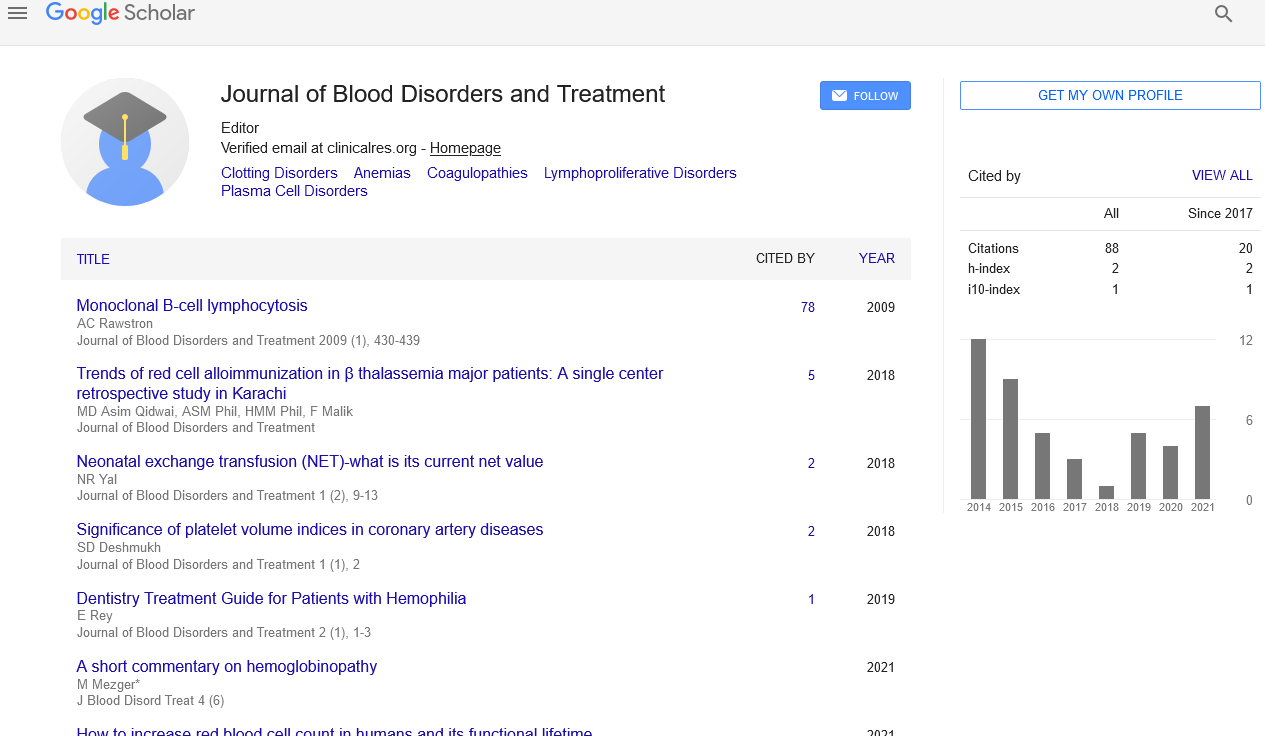Blood Cancer: Acute Lymphoblastic Leukemia
Hyderabad
, India,Received: 02-Mar-2021 Accepted Date: Mar 15, 2021; Published: 22-Mar-2021
Citation: Grace J. Blood Cancer: Acute Lymphoblastic Leukaemia. J Blood Disord Treat. 2021;4(2):1.
This open-access article is distributed under the terms of the Creative Commons Attribution Non-Commercial License (CC BY-NC) (http://creativecommons.org/licenses/by-nc/4.0/), which permits reuse, distribution and reproduction of the article, provided that the original work is properly cited and the reuse is restricted to noncommercial purposes. For commercial reuse, contact reprints@pulsus.com
Abstract
Acute lymphoblastic leukemia (ALL) may be a sort of cancer, the blood and bone marrow ,the light tissue inside bones where blood cells are made. The word "acute" in acute lymphocytic leukaemia comes from the reality that the infection advances quickly and makes immature blood cells, instead of develop ones. The word "lymphocytic" in intense lymphocytic leukaemia alludes to the white blood cells called lymphocytes, which ALL affects. Acute lymphocytic leukaemia is additionally known as acute lymphoblastic leukaemia. Acute lymphoblastic leukaemia is the major common sort of cancer in children, and medications result in a great chance for a cure. Acute lymphocytic leukaemia can moreover happen in grown-ups, though the chance of a cure is enormously decreased.
Introduction
Acute lymphoblastic leukaemia (ALL) may be a cancer of the lymphoid line of blood cells characterized by the advancement of huge numbers of immature lymphocytes. The cancerous cell in ALL is the lymphoblast. Typical lymphoblasts develop into mature, infection-fighting B-cells or T- cells, moreover called lymphocytes. Signals within the body control the number of lymphocytes so neither as well few nor as well numerous are made. In ALL, both the typical advancement of a few lymphocytes and thecontrol over the number of lymphoid cells gotten to be defective.
Initial side effects can be nonspecific, especially in children. Over 50% of children with leukaemia had one or more of five highlights: a liver one can feel (64%), a spleen one can feel (61%), pale complexion (54%), fever (53%), and bruising (52%) [1]. Also, repetitive diseases, feeling tired, arm or leg torment, and broadened lymph hubs can be unmistakable highlights. The side effects, such as fever, and weight misfortune, night sweats. Central nervous system (CNS) indications such as cranial neuropathies due to meningeal penetration are recognized in less than 10% of grown-ups and less than 5% of children, especially develop B-cell ALL (Burkitt leukaemia)presentation [2].
Diagnosing ALL starts with a careful therapeutic history, physical examination, total blood number, and blood smears. Whereas numerous side effects of ALL can be found in common ailments, persistent or unexplained side effects raise suspicion of cancer. Since numerous highlights on the restorative history and exam are not particular to ALL, encourage testing is frequently required. A huge number of white blood cells and lymphoblasts within the circulating blood can be suspicious for ALL since they show a fast production of lymphoid cells within the marrow. The higher these numbers regularly focuses to a more regrettable prognosis [3].
Whereas white blood cell checks at starting introduction can shift
essentially, circulating lymphoblast cells are seen on peripheral blood smears within the larger part of cases. A bone marrow biopsy gives conclusive verification of ALL, ordinarily with >20% of all cells being leukemic lymphoblasts [4, 5]. It occurs most commonly in children, particularly those between the ages of two and five.
The aim of treatment is to actuate a enduring remission, characterized as the nonappearance of detectable cancer cells within the body, here have been strides to extend the viability of treatment regimens, resulting in expanded survival rates. Possible medications for intense leukaemia incorporate chemotherapy, steroids, radiation treatment, seriously combined medicines, focused on treatment or growth factors.
Conclusion
Acute Lymphoblastic is thought to happen after harm to DNA causes lymphoid cells to undergo uncontrolled development and spread all through the body. Splenomegaly and hepatomegaly happen due to sequestration of platelets and lymphocytes within the spleen and liver as the white blood cells are not normal the spleen reacts to them by attempting to expel them from the blood.
REFERENCES
- Ramamoorthy R, Kanagasabai V, Kausalya R. Impact of celebrities' image on brand. Int J Pure Appl Math. 2018;119(12):3625-30.
- Kordyuk AA. Electronic band structure of optimal superconductors: From cuprates to ferropnictides and back again. Low Temp Phys. 2018;44(6):477–86.
- Bardeen J, Cooper LN, Schrieffer JR. Microscopic theory of superconductivity. Phys. Rev. 2017;116(17):162–4.
- Sabarish R, Rakesh NL. Outcome of inserts for enhancing the heat exchangers, Int J Pure Appl Math. 2017;116(17):419-22.
- Sangeetha M, Gokul N, Aruls S. Estimator for control logic in high level synthesis, Int J Pure Appl Math. 2017;116(20):425-28.





